Wednesday, July 24, 2013 was a day to learn about the upper west side of Manhattan, one of the borough’s in New York City. The experience began in Pennsylvania Station at the information booth where the group gathers each session; exiting the station and walking up Broadway. The group stopped to discuss the city’s new Citi bikes and pedestrian zones.
The New York City Department of Transportation (DOT) recognized the dangers of being a pedestrian, biker rider and driver in the borough. Pedestrians coming off the subway face numerous problems crossing the street to catch a bus putting their life on the line crossing and the vehicle drivers, when the unexpected pedestrian steps in the vehicles path the driver, attempting to avoid the person hits another vehicle or structure. The DOT has addressed pedestrian safety with redirecting vehicle traffic and creating pedestrian safe zones throughout the five boroughs. A map of the pedestrian safe zones is seen below.
The New York City Department of Transportation (DOT) recognized the dangers of being a pedestrian, biker rider and driver in the borough. Pedestrians coming off the subway face numerous problems crossing the street to catch a bus putting their life on the line crossing and the vehicle drivers, when the unexpected pedestrian steps in the vehicles path the driver, attempting to avoid the person hits another vehicle or structure. The DOT has addressed pedestrian safety with redirecting vehicle traffic and creating pedestrian safe zones throughout the five boroughs. A map of the pedestrian safe zones is seen below.
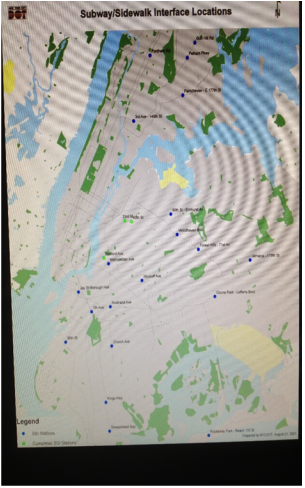
Pedestrian traffic throughout the city is immense but nowhere is it as thick as in mid-town Manhattan. To address this problem DOT built wider pedestrian walkways, bike paths and public gathering places between W. 35th and W. 42ND Streets (click hyperlink to view map of the area). In addition to gathering and greater walkway space for pedestrians the largest bicycle-sharing program was launched on May 28, 2013. Citigroup financed the project opening 300 stations and 6,000 bicycles with the intention of opening 300 more stations.
Mayor Bloomberg effectively found a new public transportation system without using taxpayer dollars that is environmentally sustainable and increased a person’s physical activity; kudos to Mayor Bloomberg’s initiative for the people.
The experience continued along Manhattan’s theatre district and we discussed the heavy crime in the 1970’s to now, this is the safest city in the world forty years later. In the 1970s and 1980s 42nd St. was a known area filled with crime so much so the police could not control it; prostitutes where everywhere, XXX movies, men would stand outside 0.25 cent peep shows attempting to lure in the customers. The question is should the old Times Square have been cleaned up or is it better the new Times Square should look like a wannabe Las Vegas? Many have argued the old Times Square should have been cleaned. On February 13, 1979, The Guardian Angels formed under the leadership of Curtis Sliwa. The group initially called the Magnificent 13 wore red berets, white t-shirts and red jackets, making them immediately recognizable. The Guardian Angels began in New York City’s Borough of Manhattan with the mission to protect the citizens of New York against predators when they cannot defend themselves. Today the Angels are in six countries including Japan, the goal is to bring violence prevention programs to schools and communities across America (guardianangels.org).
The experience brought us through Rockefeller Center where it was learned that in 1933 artist Diego Fresco and left wing artist was appointed the position to paint the theme of “man’s new possibilities, from his new understanding of material things’ (Blue Guide p. 249) Diego instead painted an illustration of Lenin’s Tomb. Lenin’s Tomb was the grave site of the Soviet leader Joseph Stalin: Stalin was thought to be a great leader and man who saved his people: yet he led by intimidation and the murder of 20 million people. Joseph Stalin died in 1953 and his body was placed in an honorary spot next to the body of Vladimir Lenin. On October 31, 1961 Stalin’s body was removed from the tomb in a move known as De-Stalinization. Diego’s painting included Lenin, workers surrounding the tomb with red flags, rich people playing cards with sexually transmitted diseased cells above them (Blue Guide p249). According to the Blue Guide Diego was asked to change Stalin’s face to another’s, he refused and Rockefeller destroyed the mural.
We walked past the ice rink below, the Statue of Atlas and Saint Patrick’s Cathedral which is located across from Atlas on 50th St. and 5th Ave. Our destination was MOMA, the Museum of Modern Art on 57th Street. According to the Blue Guide (p 260) in 1929 Aldrich Rockefeller, Lilly Bliss and Mary Sullivan founded a small museum on Fifth Avenue near Fifty-Seventh Street the first show was a huge success attracting over 47,000 visitors. MoMa eventually moved to its present location beginning as a Brown Stone. Recently MoMa underwent an $858 million dollar renovation. The developer Yoshio Taniguchi, completed the project in 2006; the project increased space for MoMA’s educational drive featuring an auditorium that seats up to 125 people, areas to study and train teachers.
We viewed the work by Jackson Pollack and Rothko, both, abstract expressionists. An abstract expressionist is a style of art that cannot be seen and is not concrete it is about evoking mood. Jackson provokes anger and hostility in his work whereas Rothko blends his colors in organic shapes. Mike described this as freeing ourselves from outmoded antiquated thought and behavior. Abstract art brings attitudes and emotions to the surface.
Jasper Johns and Roshenburg where partners whose paintings included found objects to paint over. This style of painting helped form POP art some famous POP art artists are Andy Warhol and Ruscha. Damian brought us to the “White Canvas’ and explained art should get us thinking, I agree, but a white canvas? I do not know about this.
Contemporary Art was our next stop on the second floor, contemporary art is art that is created during our lifetime. Contemporary art begins around 1960-1970s probably because the term post-modernism popped up at this time.
Mayor Bloomberg effectively found a new public transportation system without using taxpayer dollars that is environmentally sustainable and increased a person’s physical activity; kudos to Mayor Bloomberg’s initiative for the people.
The experience continued along Manhattan’s theatre district and we discussed the heavy crime in the 1970’s to now, this is the safest city in the world forty years later. In the 1970s and 1980s 42nd St. was a known area filled with crime so much so the police could not control it; prostitutes where everywhere, XXX movies, men would stand outside 0.25 cent peep shows attempting to lure in the customers. The question is should the old Times Square have been cleaned up or is it better the new Times Square should look like a wannabe Las Vegas? Many have argued the old Times Square should have been cleaned. On February 13, 1979, The Guardian Angels formed under the leadership of Curtis Sliwa. The group initially called the Magnificent 13 wore red berets, white t-shirts and red jackets, making them immediately recognizable. The Guardian Angels began in New York City’s Borough of Manhattan with the mission to protect the citizens of New York against predators when they cannot defend themselves. Today the Angels are in six countries including Japan, the goal is to bring violence prevention programs to schools and communities across America (guardianangels.org).
The experience brought us through Rockefeller Center where it was learned that in 1933 artist Diego Fresco and left wing artist was appointed the position to paint the theme of “man’s new possibilities, from his new understanding of material things’ (Blue Guide p. 249) Diego instead painted an illustration of Lenin’s Tomb. Lenin’s Tomb was the grave site of the Soviet leader Joseph Stalin: Stalin was thought to be a great leader and man who saved his people: yet he led by intimidation and the murder of 20 million people. Joseph Stalin died in 1953 and his body was placed in an honorary spot next to the body of Vladimir Lenin. On October 31, 1961 Stalin’s body was removed from the tomb in a move known as De-Stalinization. Diego’s painting included Lenin, workers surrounding the tomb with red flags, rich people playing cards with sexually transmitted diseased cells above them (Blue Guide p249). According to the Blue Guide Diego was asked to change Stalin’s face to another’s, he refused and Rockefeller destroyed the mural.
We walked past the ice rink below, the Statue of Atlas and Saint Patrick’s Cathedral which is located across from Atlas on 50th St. and 5th Ave. Our destination was MOMA, the Museum of Modern Art on 57th Street. According to the Blue Guide (p 260) in 1929 Aldrich Rockefeller, Lilly Bliss and Mary Sullivan founded a small museum on Fifth Avenue near Fifty-Seventh Street the first show was a huge success attracting over 47,000 visitors. MoMa eventually moved to its present location beginning as a Brown Stone. Recently MoMa underwent an $858 million dollar renovation. The developer Yoshio Taniguchi, completed the project in 2006; the project increased space for MoMA’s educational drive featuring an auditorium that seats up to 125 people, areas to study and train teachers.
We viewed the work by Jackson Pollack and Rothko, both, abstract expressionists. An abstract expressionist is a style of art that cannot be seen and is not concrete it is about evoking mood. Jackson provokes anger and hostility in his work whereas Rothko blends his colors in organic shapes. Mike described this as freeing ourselves from outmoded antiquated thought and behavior. Abstract art brings attitudes and emotions to the surface.
Jasper Johns and Roshenburg where partners whose paintings included found objects to paint over. This style of painting helped form POP art some famous POP art artists are Andy Warhol and Ruscha. Damian brought us to the “White Canvas’ and explained art should get us thinking, I agree, but a white canvas? I do not know about this.
Contemporary Art was our next stop on the second floor, contemporary art is art that is created during our lifetime. Contemporary art begins around 1960-1970s probably because the term post-modernism popped up at this time.
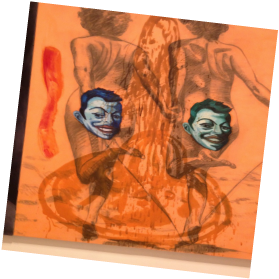
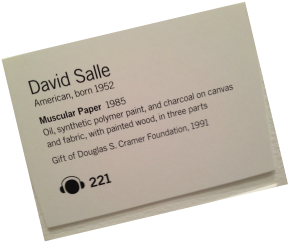
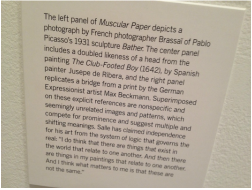
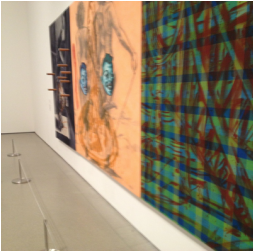
This Salle shown above has been created with oil, synthetic polymer paint and wood: in MoMA’s audio guide Salle describes each surface having a distinct texture and that the combination “creates intervals the eye has to confront and jump over”. As stated in the above description by MoMa, the panels portray works by other artists with some of Salle’s own work. Salle describes a lemon squeezer, left in a home he rented, was formed in a peculiar way; by enlarging it, caused it to lose all identity. Salle has found it to be quite comical that anyone could question the connection of the painting because “the painting is the connection”. In my subjective, non-artist mind I will have to view this painting again. The middle panel is the first panel the eye notices and quite seemingly for the few moments viewing the creation I did not notice a connection between the three, other than it came from the same artist copying others works.
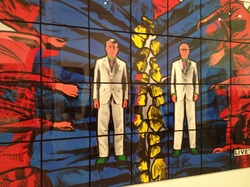
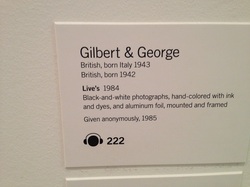
As shown above this creation by Gilbert and George, both British born artists took black and white photographs and adorned them with ink, dyes and aluminum foil. MoMAs audio teaches, that Gilbert and George who met at Saint Martin’s school of Art decided to “become the art work”. This piece Lives’ is constructed of twenty – eight photographs; creating a big negative picture “looking like stained glass”. Personally, upon my first interaction with the painting I thought of the Spiderman comic; the red and blue truly competes with the two figures Gilbert and George in the middle, I like the uniqueness of this particular style.
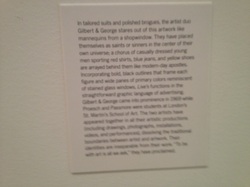
Upon leaving MoMa we detoured downtown to 42ndSt. And caught the subway to 135th and Lenox, where we met Jim, our tour guide and urban historian. Standing across from the Harlem Hospital, Jim was able to point out where Governor Patterson lives, Lenox Terrace the world’s largest brewery, and the Riverton Housing Project, this is subsidized housing overlooking the Harlem River. Lenox Avenue, Jim explained goes by two other names, the best way to remember them is to remember the “X”
Malcolm X
Leno X Avenue
Si X Avenue
Malcolm X
Leno X Avenue
Si X Avenue
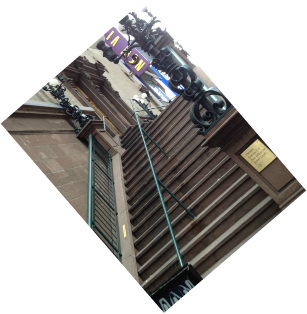
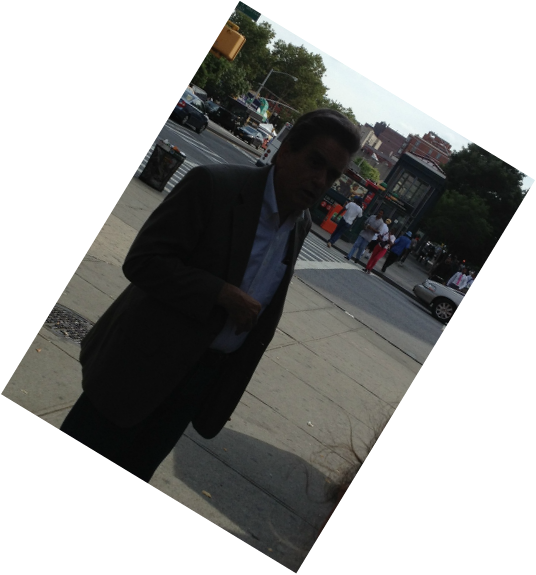 Jim, our tour guide
Jim, our tour guide 
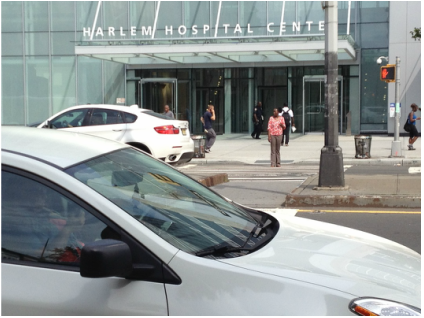
 Windows of the hospital: people inside can see out, those outside cannot see in.
Windows of the hospital: people inside can see out, those outside cannot see in. As it is in all of the five boroughs, Manhattan was settled by the Dutch with Harlem named in 1655/56 the Blue Guide states the Dutch named it Nieuw Haarlem the area is said to have been very beautiful attracting farmers and wealthy merchants. The Irish where brought in to work on the railways along with the Italians and Germans. The Jewish people flocked to the area: according to Jim the Jewish population reached 90,000 people.
According to the blue Guide (p 437), in the late 1800s early 1900s it was speculated the white middle class would move to the area when this did not happen the market collapsed. In 1904 a black realtor named Philip Payton took over management and promised higher rents if blacks were allowed to move into the area. White business owners fought to keep Harlem white but according to the Blue Guide it was too profitable to rent to blacks thus, the African American population filled in the housing space and almost tripled in a twenty year time span.
Harlem houses an interesting history: the landmarked area of Strivers Row, Apollo Theater, The Harlem Walk of Fame, and the infamous Cotton Club. Harlem is home to many famous people namely: Alicia Keys, Queen Latifa, Governor Patterson, Harry Belafonte, Orson Wells and Jack Johnson the first black fire fighter amongst others. President Clinton’s office space is in Harlem.
Strivers Row, built by David C. King and two other builders Stanford White and Bill Washington in 1891. According to the Blue Guide (p.441) three developers were chosen, this was done to avoid repetition. There are four rows of homes located between Fredrick Douglas and Adam Clayton Powell Boulevards: The homes were initially known as the King Model Houses. The homes were built in speculation the white middle class would move in. In the 1920s realtors began to rent and sell the homes to black families; some of which were professionals and others who worked very hard to afford a middle class life style: King Model began to be called Strivers Row as we know it today. There is a discrepancy in our tour guides explanation of the brownstones color and the Blue guides: the Blue Guide states “On the south and north sides of 138th St are Bruce Prices Colonial Revival rows in yellow brick with terra cotta and limestone trim. James Brown Lord’s row on the south side of 138th St, has neo-Georgian red-brick houses with brownstone trim. Jim, our tour guide had suggested the brownstones were painted, he did not mention the three developers were chosen to avoid repetition nor the names of the rows.
Harlem’s walk of fame reminds one of some of the famous great musicians of all-time: Bill “Bo jangles” Robinson, a tap dancer, choreographer, actor and singer, Dizzy Gillespie a composer, musician, leader and innovator, and Billy Holiday are some of those highlighted here on the sidewalk. The National Association for the Advancement of Colored People (NAACP) once located on 135th St just east of the Walk of Fame was building number 224, this is now home to Flo’s Beauty.
There are three parks in the area, built here because building a street would prove too difficult: between 110th St and 122nd Streets, Morning Side Park was built in the 1880s. In the 1890s between 127th and 139th Streets, Saint Nicholas Park was constructed and in the same time period between 145th and 155th Streets Colonial Park, also known as Jackie Robinson Park was erected as well.
Our day came to a close with racing up the steps of Morningside Park: it is guesstimated the stair total is one hundred fifty-five steps with an incline of straight up. Mike, an athletic man raced those students who wanted to race him up the stairs and was beaten by two. I was actually impressed by his spunk, he was able to give himself a head start, thus enabling these two students to gain track time ahead of him: kudos to all who made it up. We finished with a short tour of Saint John the Divine and Columbia University were Damian graduated.
According to the blue Guide (p 437), in the late 1800s early 1900s it was speculated the white middle class would move to the area when this did not happen the market collapsed. In 1904 a black realtor named Philip Payton took over management and promised higher rents if blacks were allowed to move into the area. White business owners fought to keep Harlem white but according to the Blue Guide it was too profitable to rent to blacks thus, the African American population filled in the housing space and almost tripled in a twenty year time span.
Harlem houses an interesting history: the landmarked area of Strivers Row, Apollo Theater, The Harlem Walk of Fame, and the infamous Cotton Club. Harlem is home to many famous people namely: Alicia Keys, Queen Latifa, Governor Patterson, Harry Belafonte, Orson Wells and Jack Johnson the first black fire fighter amongst others. President Clinton’s office space is in Harlem.
Strivers Row, built by David C. King and two other builders Stanford White and Bill Washington in 1891. According to the Blue Guide (p.441) three developers were chosen, this was done to avoid repetition. There are four rows of homes located between Fredrick Douglas and Adam Clayton Powell Boulevards: The homes were initially known as the King Model Houses. The homes were built in speculation the white middle class would move in. In the 1920s realtors began to rent and sell the homes to black families; some of which were professionals and others who worked very hard to afford a middle class life style: King Model began to be called Strivers Row as we know it today. There is a discrepancy in our tour guides explanation of the brownstones color and the Blue guides: the Blue Guide states “On the south and north sides of 138th St are Bruce Prices Colonial Revival rows in yellow brick with terra cotta and limestone trim. James Brown Lord’s row on the south side of 138th St, has neo-Georgian red-brick houses with brownstone trim. Jim, our tour guide had suggested the brownstones were painted, he did not mention the three developers were chosen to avoid repetition nor the names of the rows.
Harlem’s walk of fame reminds one of some of the famous great musicians of all-time: Bill “Bo jangles” Robinson, a tap dancer, choreographer, actor and singer, Dizzy Gillespie a composer, musician, leader and innovator, and Billy Holiday are some of those highlighted here on the sidewalk. The National Association for the Advancement of Colored People (NAACP) once located on 135th St just east of the Walk of Fame was building number 224, this is now home to Flo’s Beauty.
There are three parks in the area, built here because building a street would prove too difficult: between 110th St and 122nd Streets, Morning Side Park was built in the 1880s. In the 1890s between 127th and 139th Streets, Saint Nicholas Park was constructed and in the same time period between 145th and 155th Streets Colonial Park, also known as Jackie Robinson Park was erected as well.
Our day came to a close with racing up the steps of Morningside Park: it is guesstimated the stair total is one hundred fifty-five steps with an incline of straight up. Mike, an athletic man raced those students who wanted to race him up the stairs and was beaten by two. I was actually impressed by his spunk, he was able to give himself a head start, thus enabling these two students to gain track time ahead of him: kudos to all who made it up. We finished with a short tour of Saint John the Divine and Columbia University were Damian graduated.
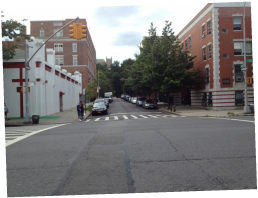

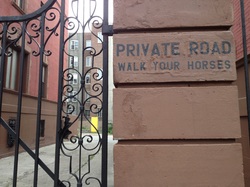
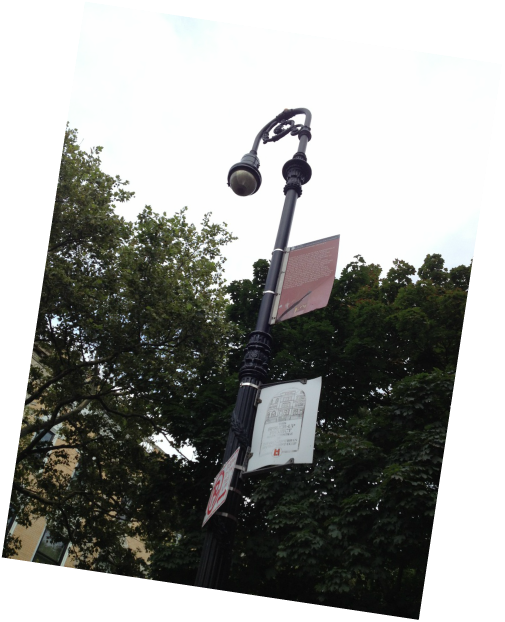
Harlem’s walk of fame reminds one of some of the famous great musicians of all-time: Bill “Bo jangles” Robinson, a tap dancer, choreographer, actor and singer, Dizzy Gillespie a composer, musician, leader and innovator, and Billy Holiday are some of those highlighted here on the sidewalk. The National Association for the Advancement of Colored People (NAACP) once located on 135th St just east of the Walk of Fame was building number 224, this is now home to Flo’s Beauty.
\
\
There are three parks in the area, built here because building a street would prove too difficult: between 110th St and 122nd Streets, Morning Side Park was built in the 1880s. In the 1890s between 127th and 139th Streets, Saint Nicholas Park was constructed and in the same time period between 145th and 155th Streets Colonial Park, also known as Jackie Robinson Park was erected as well.
Our day came to a close with racing up the steps of Morningside Park: it is guesstimated the stair total is one hundred fifty-five steps with an incline of straight up. Mike, an athletic man raced those students who wanted to race him up the stairs and was beaten by two. I was actually impressed by his spunk, he was able to give himself a head start, thus enabling these two students to gain track time ahead of him: kudos to all who made it up. We finished with a short tour of Saint John the Divine and Columbia University were Damian graduated.
Our day came to a close with racing up the steps of Morningside Park: it is guesstimated the stair total is one hundred fifty-five steps with an incline of straight up. Mike, an athletic man raced those students who wanted to race him up the stairs and was beaten by two. I was actually impressed by his spunk, he was able to give himself a head start, thus enabling these two students to gain track time ahead of him: kudos to all who made it up. We finished with a short tour of Saint John the Divine and Columbia University were Damian graduated.
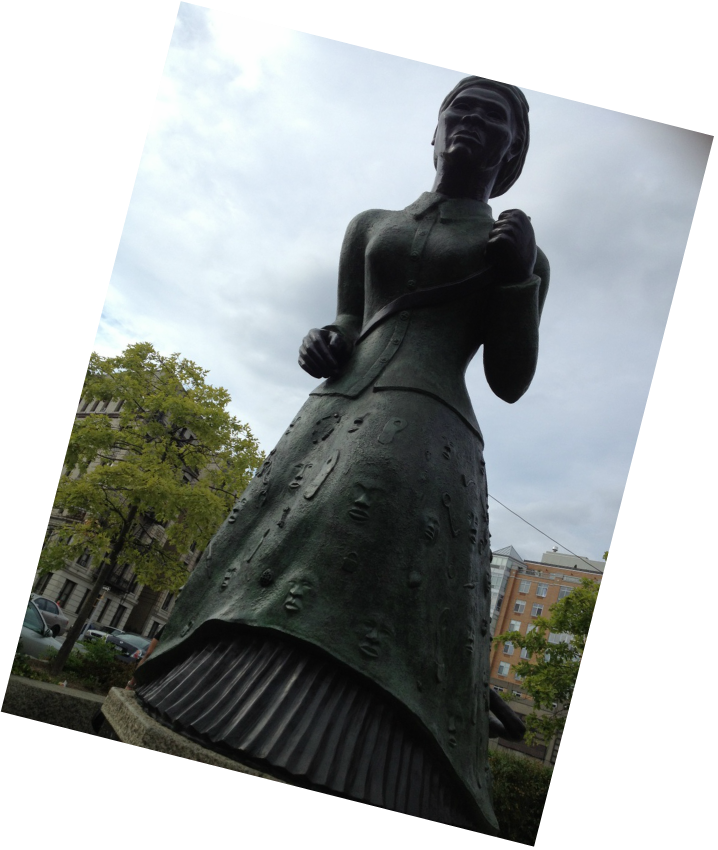

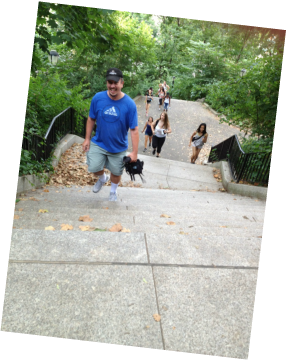
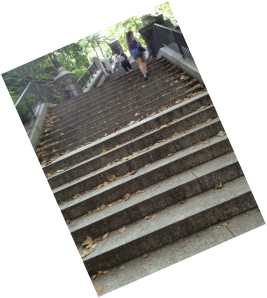
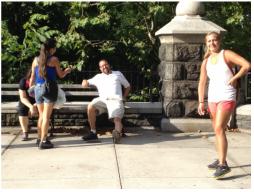
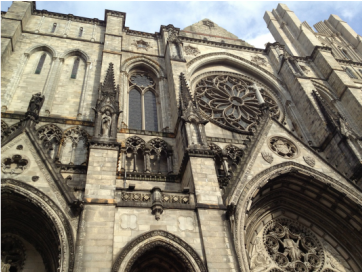
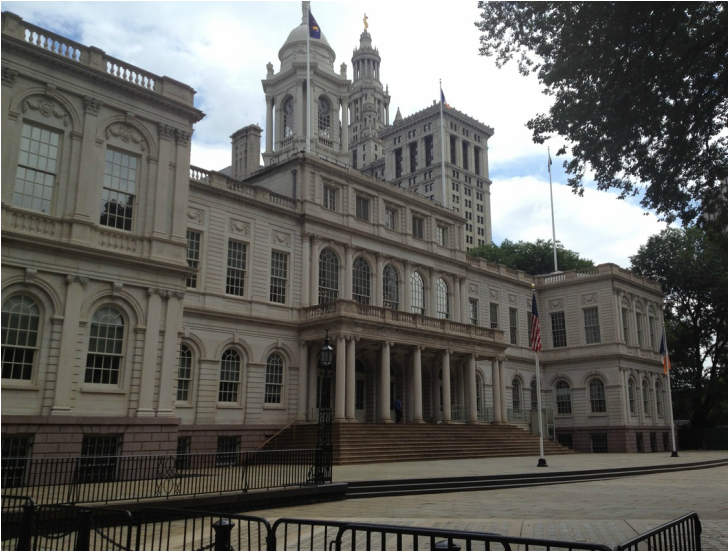
 RSS Feed
RSS Feed